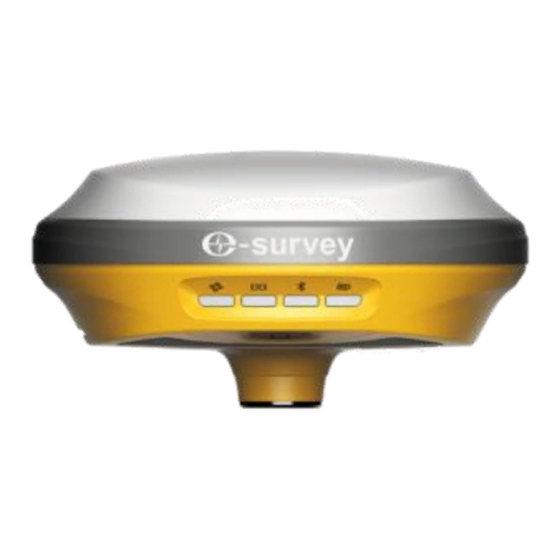
Table of Contents
Advertisement
Quick Links
Advertisement
Table of Contents

Summary of Contents for e-survey E100
- Page 1 E100 User Manual E100 GNSS Receiver User Manual V1.0_201910...
-
Page 2: Table Of Contents
E100 User Manual Contents Introduction ......................3 Appearance ....................3 Indicator ......................3 Interface ......................4 Pin definition ....................4 Power button ....................5 Web User Interface ....................5 Position ......................5 Satellites ......................6 Information ....................6 Working Mode ....................6 Satellite Setting ..................... -
Page 3: Introduction
E100 User Manual 1. Introduction This is the user manual for survey E100 GNSS receiver. It gives basic description and operation guide which may help user to operate device properly. 1.1 Appearance The E100 main body is designed with magnesium alloy material to provide durable usage and better heat dispersion as well as light weight 900g. -
Page 4: Interface
Flash red: battery level below 10% 1.3 Interface E100 GNSS receive bottom interface is shown as below. The 5-pin port is used to connect external radio and external power, or output NMEA messages. Type-C port can be used for data download (internal storage access) or charging. -
Page 5: Power Button
E100 User Manual 1.5 Power button There is a power button on E100 control panel, the main function as below: Long press button for two seconds to power on Power On receiver. Long press button for two seconds then release, Power Off will hear the voice “Power off?”... -
Page 6: Satellites
E100 User Manual 2.2 Satellites View satellite list and satellite map, set cut-off angle. 2.3 Information View receiver information: firmware version, GNSS board, and network module. 2.4 Working Mode Configurate working mode: base, rover or static. -
Page 7: Satellite Setting
E100 User Manual 2.5 Satellite Setting Configurate the satellites to be used. “RTK Timeout” setting is for aRTK service (With Hemisphere L-Band service, user cans still keep high accuracy for a period when correction data loses). “Surefix” is hemisphere technology to increase the reliability of the fixed solution. -
Page 8: Nmea Message
E100 User Manual 2.7 NMEA Message Configurate NMEA data output through Bluetooth or 5-pin port. 2.8 View Logs The log files can be used to diagnose issues. Click “download” to download the files. 2.9 Raw Data Download raw data or convert data to RINEX format. User can use check box, then... -
Page 9: Backup Data
E100 User Manual 2.10 Backup Data The points collected in SurPad4.0 will be backup in receiver storage automatically to avoid data loss. Can restore the data to SurPad software. 2.11 Management User can update receiver and GNSS firmware as well as register device, format internal disk, restore factory setting, restart device. -
Page 10: Basic Operation
E100 supports network working mode. Open the cover and insert SIM card. 3.2 Charge the battery E100 is equipped with Type-C charger which support maximum 45w PD quick charge. Fully charge the battery will take 4 hours typically. The battery indicator is red when charging, will turn green when fully charged. -
Page 11: E-Bubble Calibration
E100 User Manual 3.4 E-bubble Calibration E100 is equipped with e-bubble sensor which supports tilt survey in SurPad4.0 software. To calibrate the e-bubble, put the device on flat table or pole (ensure the bubble on the pole is normal before calibration, then centering the pole bubble). In SurPad4.0 software, connect device and click “Device”... -
Page 12: Standard Accessories
E100 User Manual 4. Standard Accessories E100 base and rover are using the same accessories. We provide easy carrying soft bag or hard carrying case. Soft Bag: Carrying Case:... -
Page 13: Technical Specifications
E100 User Manual 5. Technical Specifications... -
Page 14: Warranty Policy
If it is a non-warranty product, and the repair center will handle the maintenance of the extra-fee. After the device is repaired, the same fault is con- firmed by the repair center and e-survey will provide a 3-month free warranty service. - Page 15 E100 User Manual Damage to the product is caused by external, including but not limited to, abnormal and unpredictable factors such as satellite systems, geomagnetism, static electricity, physical pressure, etc. Damage caused by force majeure such as earth- quakes, floods, wars, etc.















Need help?
Do you have a question about the E100 and is the answer not in the manual?
Questions and answers